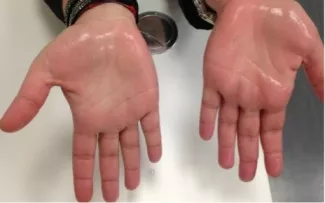Palmar Hyperhidrosis - Sweaty Hands
Overview
Palmar hyperhidrosis is a condition characterized by excessive sweating of the hands, often accompanied by severe sweating of the feet, known as palmoplantar hyperhidrosis. The severity of sweating can range from moderate moisture to dripping and can occur constantly (except during sleep or rest) or suddenly under certain circumstances.

Triggers and Symptoms
Palmar hyperhidrosis can be triggered by high temperatures or emotional stress but can also appear without any obvious reason. It typically worsens during warm seasons and improves during colder weather. Most patients notice that their hands not only become wet but also cold due to the evaporating sweat withdrawing heat from the skin surface and reduced microcirculation caused by the overactive sympathetic nervous system. The hands may often appear bluish reddish in hue.
Prevalence and Impact
- Prevalence: About 1% of the population suffers from sweaty palms, with approximately 0.2% experiencing very severe hyperhidrosis.
- Onset and Progression: The classic form of palmar hyperhidrosis usually starts in childhood and is often combined with plantar hyperhidrosis. Other types of hyperhidrosis tend to occur later in life.
- Impact on Daily Life: In school children, sweaty palms can cause difficulties with writing and other manual activities. Psychosocial distress often begins in adolescence, leading to embarrassment, avoidance of physical contact, and social interactions. The condition can also restrict career choices due to difficulty handling humidity-sensitive materials or reluctance to engage in activities like handshakes.
Causes
Palmar hyperhidrosis is almost always of genetic origin, with over 25% of affected individuals having a family history of excessive sweating. Rarely, it may be caused by underlying diseases such as neurological conditions.
Diagnosis
A typical case of palmar (or palmoplantar) hyperhidrosis does not require extensive assessment; the diagnosis is usually based on early onset in an otherwise healthy individual and the characteristic sweating pattern. Further evaluation may be necessary if excessive sweating starts later in adulthood or if symptoms appear asymmetrically, suggesting a possible neurological condition.
Treatment Options
A stepwise approach to treatment is recommended, though severe variants of hyperhidrosis (wet and/or dripping palms or fingers) may only be satisfactorily treated with surgery.
- Antiperspirants: Aluminum chloride solutions should be applied at night when sweating is minimal to allow absorption. Prolonged use may cause skin thickening or eczema, requiring treatment interruption.
- Iontophoresis: Effective for low to medium-grade hyperhidrosis when antiperspirants fail. This involves frequent treatments (e.g., 20 minutes every 1 or 2 days).
- Sympathetic Surgery: Endoscopic Transthoracic Sympathectomy (ETS) is highly effective for severe palmar hyperhidrosis, providing immediate and lasting results. The procedure should target the T3 ganglion to reduce side effects, particularly compensatory sweating, which is more common when the T2 ganglion is inadvertently affected.
- Botulinum Toxin: Not recommended for hand sweating due to several drawbacks. The procedure involves 40-80 injections per hand, which can be painful and may require local anesthesia. Temporary muscle weakness and incomplete, short-lived effects (3-5 months) make this option less sustainable and cost-effective in the long term.
